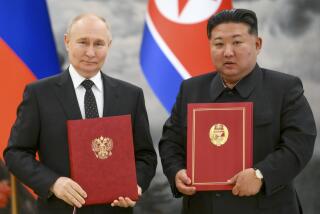U.S. Is Seen as Ready to Fulfill 1994 North Korea Reactor Deal
- Share via
WASHINGTON — South Korea’s foreign minister said Saturday that he is confident the Bush administration will go forward with a deal negotiated by President Clinton to provide civilian nuclear reactors to North Korea.
In an interview here, Foreign Minister Han Seung Soo said his talks with White House and State Department officials last week convinced him that the administration “will abide by” the agreement the Clinton administration worked out with the government in the North Korean capital, Pyongyang, in 1994.
Han’s remarks represent the second indication in recent days that the Bush foreign policy team has decided to embrace many of the central elements of the previous administration’s North Korea policy. On Wednesday, the White House announced that it was ready to reengage in a dialogue with Pyongyang.
Under the 1994 deal, North Korea is to receive two light-water nuclear reactors in exchange for freezing its nuclear weapons program and opening it to international inspection.
The reactors are being built in South Korea, with Seoul and Japan paying most of the costs. However, the United States assumed overall responsibility for putting the agreement into effect--and over the last year, Washington’s commitment had seemed increasingly in doubt.
The deal came under attack from security hawks and antinuclear activists, who shared concerns about North Korea’s obtaining additional nuclear power. Rep. Edward J. Markey (D-Mass.) urged that the North be given conventional power plants instead of nuclear ones.
Moreover, leading Republican members of Congress and some independent economists contended that North Korea’s severe energy shortages could be met better and more quickly by alternative kinds of power, such as thermal energy.
Marcus Noland, an economist with the Institute for International Economics, argued in a lengthy study last year that the two nuclear plants should be replaced “with more sensible coal-fired plants, rehabilitating the North Korean electrical grid, building transformers . . . and financing other kinds of infrastructural investments.”
When the Bush administration took office in January, officials said they were reconsidering the wisdom of the 1994 deal as part of a full-scale review of U.S. policy toward North Korea.
But since then, the administration appears to have decided that any U.S. attempt to renegotiate the terms of Clinton’s deal would create too many problems with South Korea and Japan, America’s two closest allies in Asia.
South Korea, in particular, has been eager to move ahead with the nuclear agreement. The nation’s companies have landed most of the commercial contracts for the project. And South Korean President Kim Dae Jung wants to proceed with his policy of reconciliation between the two Koreas.
In recent days, President Bush and Secretary of State Colin L. Powell have suggested a willingness to move ahead with the 1994 deal, although both appeared to leave some room for maneuvering.
Powell told reporters Thursday that Clinton’s deal “is an agreement, and we see no reason to change our position right now.”
The president, in a statement, said the new administration’s policies will include “improved implementation” of the 1994 deal, which is formally called the “agreed framework” between the United States and North Korea.
Both Bush and Powell referred obliquely to one serious obstacle that remains to be overcome before the deal is finally carried out. Under the terms of the agreement, North Korea must open its nuclear program to full-scale inspections by the International Atomic Energy Agency before it receives the two light-water nuclear reactors.
The United States wants to learn the history of North Korea’s nuclear weapons program and ascertain how much weapons-grade plutonium the North has produced. By some estimates in the early 1990s, the North produced enough plutonium to make one or two nuclear bombs.
U.S. and South Korean officials say that, so far, North Korea has not begun opening up for the inspections, which could take two or three years. The new target date for transfer of the two nuclear reactors to the North is 2008, officials say.
More to Read
Sign up for Essential California
The most important California stories and recommendations in your inbox every morning.
You may occasionally receive promotional content from the Los Angeles Times.













